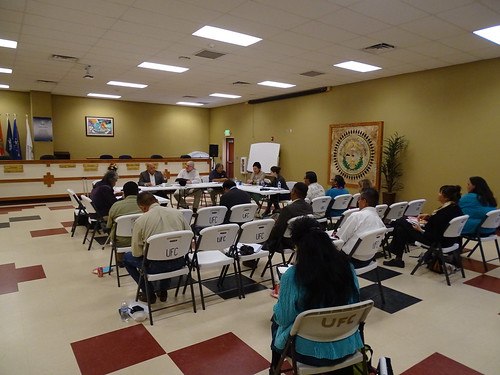
I recently traveled to New Mexico and Arizona to visit with local Navajo government leaders, Tribal College officials, and community members to hear about life on the Navajo Reservation. Michael Burns, from the Environmental Protection Agency (EPA), was also there to discuss an important new collaboration, the College/Underserved Community Partnership Program (CUPP).
CUPP develops partnerships between underserved communities and geographically close colleges and universities to provide technical support through faculty, students and staff at no cost to those communities. One of my top priorities is for USDA to help EPA expand the CUPP program to involve Tribal communities and colleges to advance the cause of environmental justice.
The first step in establishing these community-to-college relationships is asking community members what type of assistance they need. We help bring everyone together and facilitate how to better meet these local needs in a creative way that also provides hands-on, real-world experience for the students and faculty in the region.
Mr. Burns described some exciting examples of CUPP program successes so far, such as how Tuskegee University architecture students developed an alternate transportation plan for the Selma to Montgomery Voting Rights Trail area that also improves access for families to food, health facilities and employment opportunities in rural Alabama.
In New Mexico, we met with the leaders of the Nenahnezad, San Juan, Shiprock, Tiis Tsoh Sikaad, Tsé Daa K’aan and Upper Fruitland chapters of Navajo Nation. The Navajo chapter leaders were interested in how we could bring the CUPP program to their communities and involve students from local Tribal Colleges in delivering assistance. Community members also explained that bringing in Tribal College students would provide great role models for other Tribal youth and help develop strong mentoring relationships as well.
We hope to have several Tribal college CUPP partnerships by the spring 2016 semester.
The Navajo chapter leaders also told us about progress being made thanks to a recent USDA Rural Business Development Grant. The grant to Capacity Builders Inc., a local nonprofit, helps them deliver training for chapter officials and community members on how to identify, nurture and fund local business opportunities. This work helps the six chapters support and invest in businesses that create well-paying jobs and improve the quality of life for Tribal families. This is one of 28 such grants totaling $4.3 million Rural Development invested in Tribal communities to support business and regional economic development last year.
In Michigan, USDA’s Natural Resources Conservation Service recently used 2014 Farm Bill conservation programs to help two Anishinaabe tribes increase production of wild rice. Wild rice, or manoomin, serves as a staple of the Anishinaabe diet and is culturally and spiritually important to them. USDA’s Food and Nutrition Service and the USDA Center for Faith-Based and Neighborhood Partnerships are collaborating on nutrition projects that reduce high rates of food insecurity and help Latino communities meet their health goals through La Mesa Completa.
Support for CUPP along with investments and technical assistance like these highlight just a few of the many ways that USDA partners with local organizations to meet the goals in the Department’s 2016-2020 Environmental Justice Strategic Plan—and ensure that the place someone is born doesn’t determine her destiny.
Our draft Environmental Justice Strategic Plan for 2016-2020 and information on how to submit your comments are available on our Environmental Justice homepage and we encourage your input. The public comment period ends Feb. 14, 2016.


